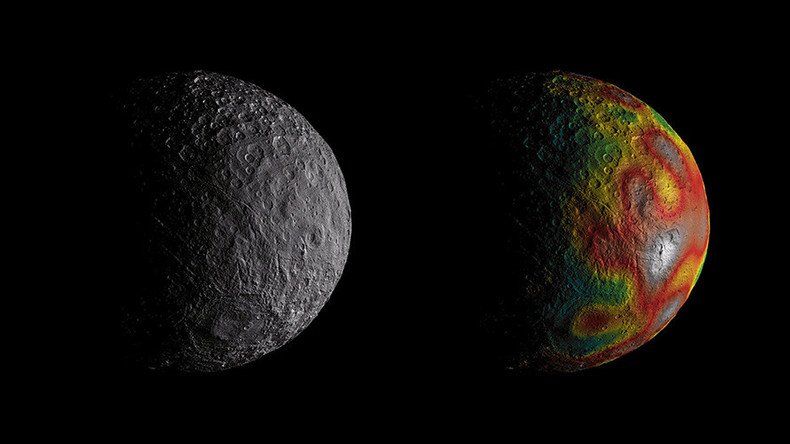Dwarf planet Ceres may have harbored vast ancient ocean

The dwarf planet Ceres may have once had a global ocean, according to new studies based on data from NASA’s Dawn mission.
The Dawn spacecraft, which has been orbiting the only dwarf planet in the inner reaches of the solar system since March 2015, obtained measurements suggesting the presence of an ancient ocean.
"More and more, we are learning that Ceres is a complex, dynamic world that may have hosted a lot of liquid water in the past, and may still have some underground," said Julie Castillo-Rogez, Dawn’s project scientist.
Could dwarf planet Ceres have had an ocean in the past? @NASA_Dawn finds widespread possible residual minerals: https://t.co/zp7Jd0aQczpic.twitter.com/Z7Y54csIwg
— NASA (@NASA) October 27, 2017
The team found that Ceres' crust is a mixture of ice, salts and hydrated materials that were subjected to past and possibly recent geologic activity. The crust represents most of that ancient ocean according to NASA.
Shape and gravity data measurements from the Dawn mission were used to determine the internal structure and composition of Ceres.
However, as previous research suggested that ice was too soft to be the dominant component of Ceres' strong crust, a further study was carried out to show how the planet’s surface evolved with time.
‘Bart Simpson’ landslide spotted on dwarf planet Ceres (PHOTOS) https://t.co/OEaPztWZJSpic.twitter.com/T8h2wSm4Et
— RT (@RT_com) April 21, 2017
It found the crust was likely a mixture of ice, salts, rock and an extra component believed to be clathrate hydrate.
Clathrate hydrate is a cage of water molecules surrounding a gas molecule that has a structure 100 to 1,000 times stronger than water ice, but has almost the same density.
Scientists noted that Ceres’ features had become less pronounced over time; pointing to a “flattening of mountains and valleys” which requires a high-strength crust resting on a more deformable layer. This in turn led them to suggest this could be the signature of residual liquid left over from the ocean.
Could Ceres still have liquid today? 2 new @NASA_Dawn studies have clues https://t.co/XvWthSm9DDpic.twitter.com/J2C7jxVMnf
— NASA JPL (@NASAJPL) October 26, 2017
While most of Ceres' ancient ocean is now frozen and has been bound up in the crust for more than 4 billion years, the team believes there still could be some residual liquid underneath.
Several thermal evolution models of Ceres published prior to Dawn's arrival on the planet also support the idea that Ceres deeper interior contains liquid left over from its ancient ocean.
READ MORE: Surface pits could be a sign of ice buried under asteroids – study
Earlier this month, NASA authorized a second extension of the Dawn mission at Ceres, the largest object in the asteroid belt between Mars and Jupiter.
Its expected the spacecraft will operate until the second half of 2018. Dawn has been in spaceflight for more than ten years and previously explored the giant protoplanet Vesta, making it the only mission ever to orbit two extraterrestrial targets.












